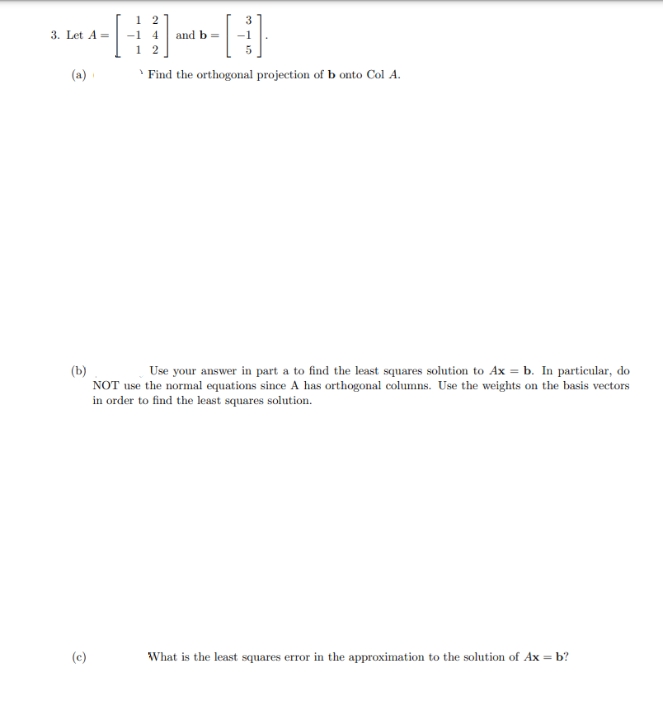-1 4 and b = 1 2 Let A = (a) . 'Find the orthogonal projection of b onto Col A. Use your answer in part a to find the least squares solution to Ax = b. In particular, do (b) NOT use the normal equations since A has orthogonal columns. Use the weights on the basis vectors in order to find the least squares solution. (c) What is the least squares error in the approximation to the solution of Ax = b?
-1 4 and b = 1 2 Let A = (a) . 'Find the orthogonal projection of b onto Col A. Use your answer in part a to find the least squares solution to Ax = b. In particular, do (b) NOT use the normal equations since A has orthogonal columns. Use the weights on the basis vectors in order to find the least squares solution. (c) What is the least squares error in the approximation to the solution of Ax = b?
Linear Algebra: A Modern Introduction
4th Edition
ISBN:9781285463247
Author:David Poole
Publisher:David Poole
Chapter4: Eigenvalues And Eigenvectors
Section4.6: Applications And The Perron-frobenius Theorem
Problem 24EQ
Related questions
Question
100%
I am struggling to understand this concept without using normal equations.
Please explain all subparts.

Transcribed Image Text:3. Let A=
-1 4 andb=
1 2
(a)
' Find the orthogonal projection of b onto Col A.
Use your answer in part a to find the least squares solution to Ax = b. In particular, do
(b)
NOT use the normal equations since A has orthogonal columns. Use the weights on the basis vectors
in order to find the least squares solution.
(c)
What is the least squares error in the approximation to the solution of Ax = b?
Expert Solution
This question has been solved!
Explore an expertly crafted, step-by-step solution for a thorough understanding of key concepts.
This is a popular solution!
Trending now
This is a popular solution!
Step by step
Solved in 3 steps with 3 images

Recommended textbooks for you

Linear Algebra: A Modern Introduction
Algebra
ISBN:
9781285463247
Author:
David Poole
Publisher:
Cengage Learning

Algebra & Trigonometry with Analytic Geometry
Algebra
ISBN:
9781133382119
Author:
Swokowski
Publisher:
Cengage

Elementary Linear Algebra (MindTap Course List)
Algebra
ISBN:
9781305658004
Author:
Ron Larson
Publisher:
Cengage Learning

Linear Algebra: A Modern Introduction
Algebra
ISBN:
9781285463247
Author:
David Poole
Publisher:
Cengage Learning

Algebra & Trigonometry with Analytic Geometry
Algebra
ISBN:
9781133382119
Author:
Swokowski
Publisher:
Cengage

Elementary Linear Algebra (MindTap Course List)
Algebra
ISBN:
9781305658004
Author:
Ron Larson
Publisher:
Cengage Learning